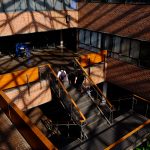UFCJC Student Works to Transform Global Platform Safety with Snap Inc.
By Jacob Sedesse, Media Production, Management, and Technology senior
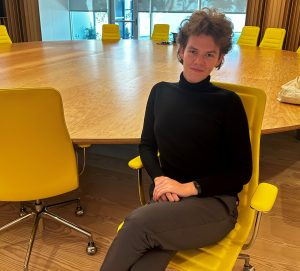
Since I stepped foot in the University of Florida College of Journalism and Communications (UFCJC), I’ve kept busy.
You may have heard my voice on WUFT-FM—the college’s in-house NPR affiliate—where I have hosted the local newscasts during Morning Edition and All Things Considered. I’ve also executive produced multiple podcasts, served as a producer and anchor of our student TV nightly newscast, First at Five, and even reported on NASA’s Artemis I mission.
All of these invaluable experiences I’ve had in the College allowed me to take my skills into the Gainesville community—the place where I was born and raised—this summer. I began a role as an assistant producer for WCJB TV20, the market-leading commercial TV station for Gainesville; reported multiple front-page stories for The Independent Florida Alligator; and even became a video content producer for Satchel’s Pizza—a local favorite! My real-world experience producing video content as a journalist and filmmaker at the College has translated to professional jobs before I even reached my senior year.
But those who know me—or see my sometimes-questionable, often-entertaining tweets—can probably tell that it’s not just the process of making a TV report or shooting a short film that interests me. It’s the art and science of communication, or more specifically, the technology that allows us to perform it. I enjoy learning about the newest innovations, whether I’m using them to create something special or even cover the technology, like I did when I created WUFT’s TV technology news segment “Tech Tomorrow.”
Technology sets the boundaries in which we can communicate. On the first day of my Telecommunication Law & Regulation class with UFCJC Associate Professor Jasmine McNealy, we learned of Lawrence Lessig, who famously wrote that “code is law.” Lessig described how the computer systems we build inherently enforce the views and principles of their designers—whether they are literally designed to enforce rules or instead shape what we can or cannot do with that program.
This is not supposed to be a computer science lesson—coding never clicked with me. But as my classmates and I prepare to be sent into a workforce, where we must effectively use computer systems and social platforms to reach our mass audience, it’s important to understand how these rules and principles can affect our livelihoods.
So, I took a trip out to California to help make a change.
Last year, the college reported that I was preparing to work on safety policies for Snapchat as a youth member of Snap’s Safety Advisory Board (SAB). (Snap Inc. is the company that develops the Snapchat app, among other products and services.) This June, Snap flew me out to its Santa Monica headquarters for our first official in-person gathering as a group. For two-and-a-half days, I was chauffeured around Los Angeles with experts from academia and non-profits across technology, child safety and other applicable fields. We ate some of the best food I’ve eaten in my entire life, shared many laughs, and most importantly, worked to answer a challenging question: “What is the future of safety online?”
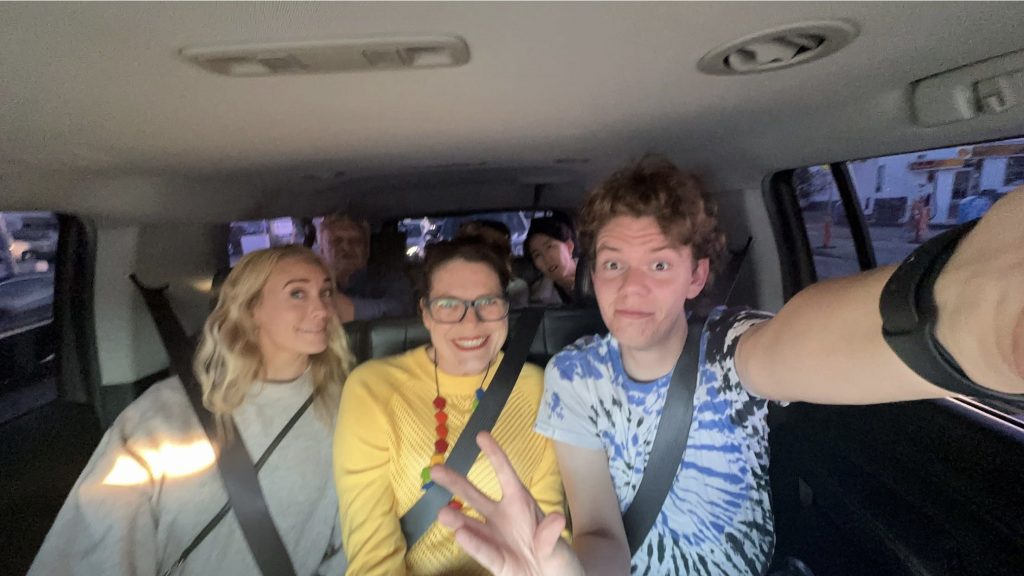
“Somewhere you can go in without worrying about predators,” said fellow youth board member Castra Pierre, a former member of the United Nations group Girl Up in Haiti (and my designated best friend during the trip). “Somewhere you feel safe.”
Okulaja, another member of the youth cohort and a social media influencer, described it as “a place where people can go on any social media platform and genuinely feel safe, and if they get into any issues, they know how to properly deal with it.”
“I think we’re moving away from a time where online safety was prescribed by traditional experts and moving more towards a time where lived experience expertise is shaping the way that we think about concepts like safety,” said Lucy Thomas, founder of Project Rockit, an Australian organization that trains young people to mobilize against bullying—and a member of my project group at the SAB.
We took these worldviews and applied them to Snapchat, which, unlike most social media platforms with public posts, is largely centered around private chats between friends. With this in mind, we had to turn all the work we’d done previously upside down, because the safety of a larger platform was not our main concern. Instead, we had to look at how we could make teens feel safer on the platform and bring comfort to parents without compromising privacy—a principle I’m unwavering on.
Beyond chat, Snap has also entered the artificial intelligence (AI) race with its My AI feature—a personal AI chatbot who can hold impressively realistic conversations with you. Of course, we played around with it at dinner—watching the experts get amused by my avatar’s silly answers to our questions was certainly one of the highlights of the experience. But it also raised even deeper ethical questions about what should be off-limits for this AI system. My answers certainly called back to lessons I learned in “AI in Media and Society” with UFCJC Journalism Professor Mindy McAdams.
We drilled down to each of Snap’s key feature sets and broke off into groups to tackle specific issues facing the platform today. Working with Lucy Thomas in my group, I was able to teach her about my current youth experiences on the app while I learned from her about differences in family cultures between Australia and America.
“The issues that we approach as part of the SAB aren’t novel to any of our work, but what is novel is the opportunity to come together with people from all over the world who have different connections to those issues,” Thomas said. “The experience for me is having my assumptions checked, challenged and supported. A real culture of ‘yes-and.’”
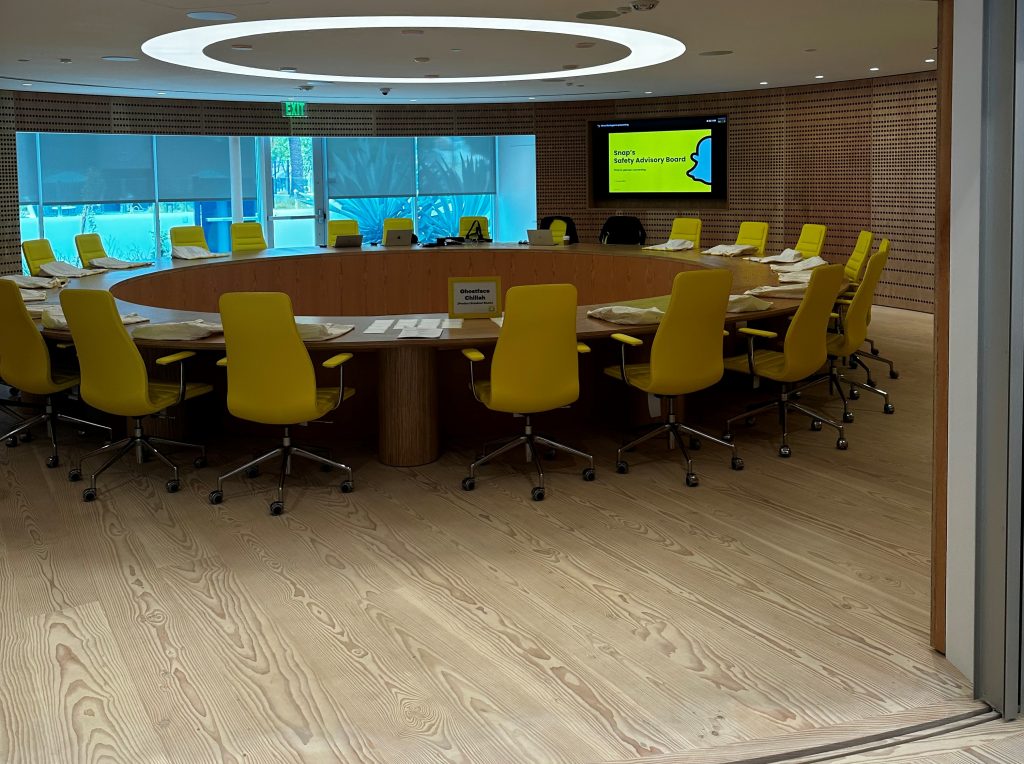
This wide gamut of experiences, knowledge and connections to the issues is exactly what Snap wants for advising on its policies.
“The SAB exists to guide, council and advise Snap on ‘all things safety,’” said Jacqueline Beauchere, global head of platform safety at Snap Inc., and the creator of the SAB. “It serves as a sounding board, bringing together a group of experts in their fields and safety-related disciplines to work with us as we aim to safeguard the Snapchat community.”
These are tough problems to solve—even for the experts, as I’ve learned. Sitting at a conference room table with such important minds in the field would be a daunting task for anyone; try it being a college student with a fear that you’ll be written off for being naïve or “addicted to the phone.” As it turns out, it was the opposite—not only did the wealth of information I’ve gathered from my UF education impress those I worked with, but my experiences as a young person who grew up on social media was exactly what all those experts wanted to hear. Being a young professional working in media only helped sweeten the deal.
“Having three members of the Snapchat generation on that board is essential for us, because we want to have that all-important youth voice in our discussions at that strategic level,” Beauchere said.
I made a really great connection with my fellow youth members—the three of us sat at the end of the table together every day and the experts frequently looked to us, directly asking what we thought.
Castra Pierre, a college student like myself, said she initially felt intimidated presenting to adults.
“My colleagues… some of them never used Snapchat in the first place,” she said.
However, Pierre said that teaming up with me as part of the board’s youth cohort helped us both become more comfortable sharing what we truly knew—the way that teens use Snapchat.
Okulaja pointed out that even within the small youth cohort, we had such different backgrounds that helped us to balance each other out—but, make no mistake, those diverse experiences did not create a harsh difference in opinion.
“Whilst we all had our differences at some point, there was almost one voice,” Okulaja said. “I don’t think there was much of a disparity between the thoughts of young people and the thoughts of the adults.”
Overall, the group was so welcoming to me and the youth cohort’s ideas and knowledge and I was grateful to have a seat at the table. Before I arrived, I was nervous that I would not be able to carry my weight, but the faith of Beauchere, my adviser, gave me the confidence I needed to make my voice heard.
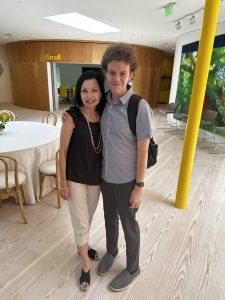
This was not my first time working with her. As a teen, I served on Microsoft’s Council for Digital Good when she was the company’s Chief Online Safety Officer. Without the knowledge I had then, I was simply a kid who had grown up not knowing what it was like before the internet, sharing stories of my experiences online at age five that made the adults’ jaws drop. The way I openly shared my experiences helped me stick out to her.
“You were obviously very engaging, you were very thoughtful, you were very participatory, and I loved all of that,” Beauchere said.
Since the Microsoft work, we stayed in touch infrequently. In our long time apart, I grew several inches and lost a significant amount of weight. When we reunited, she said I was unrecognizable. But most important, during that time I gained a world-class education in ethical digital communications and jump-started my career in media at UFCJC—developing a wealth of knowledge that allowed me to advance the work I’d been doing since I was a teen.
“When I moved over to Snap and we were reinventing our Safety Advisory Board here, you were of course a little bit grown up from when I met you at 15 or 16,” Beauchere said. “You received feedback from our selection committee across the board as being somebody whom we wanted on the board.”
With my new and expanded knowledge from UFCJC, I was able to build off this connection I had made years ago as a teen and create a brand-new opportunity to help shape the future of communications platforms.
Category: College News, Profiles
Tagged: Digital Safety Jacob Sedesse Snap Snapchat
Subscribe to our News Digest

